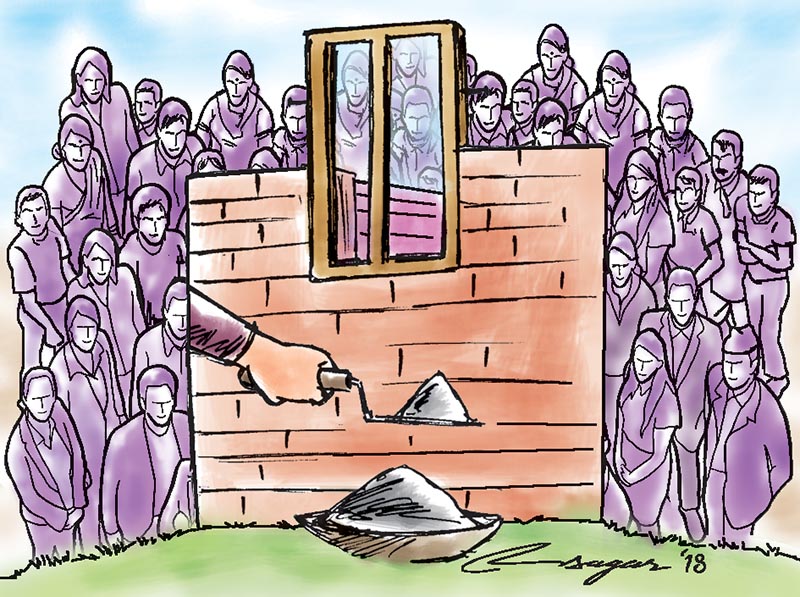Housing reconstruction: Insights from the field
Almost 800,000 houses are to be reconstructed or retrofitted in the private housing sector which of course is the utmost priority. It is both an opportunity and a challenge depending upon how we handle it
It has been three years since the devastating 2015 Gorkha Earthquake and hence massive reconstruction in several sectors of infrastructure, heritage sites and public buildings among others isongoing. JICA is also conducting a diverse set of EQ recovery cooperation ranging from physical reconstruction of infrastructure and public buildings such as schools and hospitals to non-structural recovery such as livelihood revitalisation.
However, we have been facing quite a few bottlenecks in those operations. The financial assistance for school reconstruction is one of the most critical areas where most employed contractors cannot follow given deadlines, and only seven out of more than 80 schools that were supposed to be completed until today have been completed. Basically, JICA’s cooperation strategy is “working together” and our cooperation projects cannot stand without the corresponding efforts and inputs by Nepali counterparts such as the government and private sectors. Through the experience with school reconstruction, we have learned we cannot expect much on the implementation capacity of Nepal as a whole system of public and private sectors. Mobilising external resources like Japanese companies for swift implementation might be a solution for such cases, at least in the emergency phase, but this would not yield sustainable development effects for Nepal in the long run. Almost 800,000 houses are to be reconstructed or retrofitted in the private housing sector. It is both an opportunity and a challenge depending upon how we handle it.
JICA is extending its cooperation for the reconstruction of about 55,000 houses in Gorkha and Sindhupalchowk. Some of the major supports provided to the beneficiaries are – housing grant as financial support, building catalogue to support earthquake resilient houses design, training to masons on earthquake resilient techniques, and periodic inspection from engineers to ensure that the houses are reconstructed as per the earthquake resilient techniques. The reconstruction progress had been below the expectations as only 21.3 per cent of the beneficiaries started reconstructing their houses by the end of March 2017. Considering the slow reconstruction rate despite technical assistance by mobilising the engineers and social mobilisers, JICA introduced Community Mobilisation Programme (CMP) since May 2017. Not only the insufficient capacity of public and private actors in Nepal but also the geographical circumstance of scattered affected households was making the owner-driven reconstruction modality significantly difficult. Public help by the government could not fully outreach them and private sectors such as construction workers or logistic suppliers were kept busy in the more lucrative works in urban areas or abroad. This situation gradually shifted us to consider employing the imprinted knowledge and social capital of the community as the final hope.
In cases of Japan, disaster reconstruction processes have been conducted in ways where public and private resources are fully mobilised to attain the swift recovery. Beginning from publicly providing temporary housing for the affected households by the government, most of the affected people can wait either being provided land plots in the relocation settlements to build their own houses with contracting out to private builders, or even being provided public housing for those who cannot afford to build their own houses. Since Nepal is not so much well developed and equipped as a system, people cannot depend on the public or private services not only in the disaster recovery but also in their daily lives.
CMP was designed with a simple logic to address the simple looking but complex socio-technical issues of the house owners. The core aspect of CMP is recruiting and fielding “mobile masons” to a cluster having around 100 houses to be reconstructed. Several community workshops/meetings are organised to identify the problems faced by the beneficiaries and the community and to prepare the action plans to address those problems. Also the mobile masons support the house owners to manage construction materials, masons/labours, inspection, house layout, etc. Furthermore, the engineers and the mobile masons conduct on-the-job training to those masons from outside who have not received training on earthquake resilient techniques.
The CMP is quite effective in order to address various issues of the house owners and communities, thus enabling them to undertake housing reconstruction. This is also helpful to support the construction of houses of those vulnerable people. It was successful in providing the comprehensive and much needed socio-technical support at their door revitalising our historical culture of mutual-help. The hypothesis that Nepali communities are much stronger in terms of mutual-help has been proven with this experience. The success of the CMP was because it hit the core strengths of our communities – the culture of “mutual help”. Now, embedding all the learning from the field, we are in a position to affirm that the “Owner-Led Community Driven” approach works in our context particularly for private housing reconstruction.
Bhandari is program manager, Emergency Housing Reconstruction Project, and Nagami is senior representative, JICA Nepal






